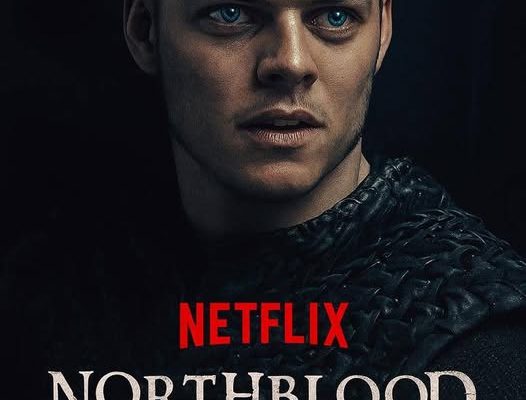In the frozen north of legend, where the roar of longships and the clash of axes shattered silence and wrought new empires, one name stands out among the warriors of myth and history: Björn Ironside. According to the sagas and medieval chronicles, Björn, son of the formidable Ragnar Lodbrok, rose from youth to kingship, raid to rule, forging a destiny that would ripple through the centuries. Wikipedia+2vikings.fandom.com+2 His story now finds new life on Netflix, inviting modern audiences to witness the legend, the man, and the warrior who defied the limits of his age.
Björn Ironside’s tale begins, as myth often does, in tumult: born in the 9th century amid raids, shifting allegiances, Viking longships slicing across seas, and the looming shadow of death and glory. According to the Icelandic sagas, he was the son of Ragnar Lodbrok and his wife (or concubine) Aslaug — and brother to names such as Ivar the Boneless and Hvitserk. Wikipedia+1 Historical sources attest to a Björn attested in the years 855 and 858, suggesting that while the saga embellishes, there is a foundation in fact. Wikipedia+1 What draws us beyond the bare historical ledger is the man’s journey: from inexperienced son to seasoned warrior, from follower to leader, from legend to nearly mythic status.
The Netflix incarnation of this story leans into the sweeping drama: the early years of Björn seeing his father’s shadow, longing for recognition, grappling with the demands of family, honor, and raiding. He watches Ragnar march off on expeditions, he witnesses the brutality and the glories of the north, and he slowly begins to carve out his own path. The show gives him room to breathe, to grow — from boy to man, from prince to king of Kattegat. (In earlier televised tales such as Vikings, Björn appears as Ragnar’s son and rising figure. vikings.fandom.com+1) This version adds weight to the inner turmoil: the desire for glory, the conflict between loyalty and ambition, the cruel cost of power.
Björn’s nickname “Ironside” captures both mythic and symbolic weight. In the sagas he is said to have survived wounds that would have felled other men, to have fought through storms and storms of men, to have carved a reputation so fearsome that his name alone could stir the enemy. vikings.fandom.com+1 The Netflix version embraces this: battle sequences where longships crash into moored barges, axes sing, the wind howls, shields splinter, and Björn stands, blood‑soaked but unbowed. His personal journey becomes a metaphor: the forging of an “iron side”, the resilience to stand against the tide, familial expectations, and the legacy of a father who looms larger than life.
But the story is never simply about war and conquest. The show gives space to the complexities of Björn’s character: his loyalty to his mother and father, his grudging respect (and rivalry) with his brothers, his relationship with his people in Kattegat. He is the heir of Ragnar’s ambition, but he also must wrestle with Ragnar’s flaws: the man who led raids across the sea, sought fame, yet left fragments of himself behind. In this sense Björn becomes more than “son of Ragnar” — he becomes a bridge between the era of legendary raids and the era of settlement, rule, and legacy.
In one of the story’s crucial arcs, Björn decides that his destiny lies not just in raiding but in exploring the wider world. He sails into the Mediterranean, striking at far‑flung lands, testing the boundaries of the Viking sphere. In the sagas he is credited with shifting focus from mere pillage to ambition, from boat to throne. Wikipedia+1 On Netflix, these episodes shimmer with ambition, a Viking longship under soaring skies, unfamiliar coasts, new cultures, the sense of crossing thresholds: not merely geographic but existential. Björn must ask: who am I beyond Ragnar’s son? What kind of king will I be? Will I be bound by the old ways — or invent new ones?
The relationship with Kattegat, the homeland, becomes central. As Ragnar’s era winds down, as rivals circle, as internal conflicts and betrayals emerge, Björn returns — not as boy, but as manhood sharpened by travel, battle, scars. He must prove his right to rule, to steer his people, to stand when others falter. And when war returns to the door of Kattegat, Björn is ready. The show captures this transition gracefully: the longship returning to shore with its bowbreaking crest, the warriors stepping onto land scarred and changed, the fields of home no less dangerous for being familiar.
What makes this version of Björn’s tale compelling is its balance of spectacle and introspection. Yes, there are pitched battles, longships riding waves, axes swinging in fire‑lit halls. But there is also the quiet aftermath: the warrior alone on the moor, staring at the stars; the king seated at his table, wondering whether the so‑called spoils of war mean anything; the son of Ragnar looking at his father’s legacy and doubting whether he wants to repeat it or transcend it. Many moments in the show reflect this tension: the call of the sea vs. the responsibility to the land; the glory of battle vs. the cost paid in human lives; the legend vs. the man. Viewers who follow along will find themselves not just cheering victories but asking: is this what Björn wanted? Is this what we truly want?
Another layer to the story is the blending of history and legend. Real sources place a Björn in the mid‑9th century, linked to Swedish kingship and Viking raids. Wikipedia But the sagas amplify, transform, mythologise. The show doesn’t shy away from that: it allows the epic to breathe, even as it plants its feet in historical plausibility. That gives it texture — we live in an age of big blockbusters and “based on a true story”, but here the truth is augmented by myth, and that’s precisely the point: legends endure because they transcend mere fact. Björn Ironside is offered to us as both man and myth, warrior and legend.
From a production standpoint, the Netflix release brings visual scale and modern storytelling craft to this tale. The longships gliding under blood‑red skies, the fjords and shores of Scandinavia, the marketplaces of Mediterranean cities, the tension of war councils, betrayals, alliances – all executed with ambition. The cinematography doesn’t shirk from the brutality of the era: Death is ever‑present, survival uncertain, the line between heroism and atrocity thin. And in the middle of that, Björn stands — flawed, ambitious, sometimes impetuous, always compelling.
As viewers in 2025 (even in Uyo, Nigeria) tune in to stream Björn’s saga, there is a global context at play. The Viking story has become part of our shared cultural mythology. It appeals across continents because it deals with universal themes: father and son, ambition and legacy, war and peace, home and exile, legend and reality. Björn’s story resonates because it’s not only about Vikings; it’s about what it means to defy the expectations laid on you — to look at the path you’ve inherited, and ask: will I walk it, or carve my own? In a world that often asks individuals to conform, Björn Ironside’s tale says: you can carve your own name.
If there is any critique to lodge, it might be that in weaving legend into spectacle, the show sometimes simplifies or condenses complex historical realities. The saga’s richer contextual threads — early medieval politics, Viking society’s internal dynamics, the roles of women and non‑warriors in the age — are touched on but not always deeply explored. But perhaps that is a concession to storytelling: to keep the focus on Björn and his arc. And even then, the show frequently reminds us that heroism is messy: Björn makes mistakes, loses friends, sees innocence die, grapples with whether power is worth the cost. That complexity lifts it above mere “blood‑and‑swords” fare.
For anyone unfamiliar with Björn Ironside before this release, Netflix’s telling is an excellent entry point. It offers the spectacle of Viking raids, the beauty of Norse landscapes, the violence and the camaraderie of the warrior‑age. But perhaps more importantly, it offers a character journey: of a young man stepping out of a father’s shadow, of a warrior realising that what he fights for matters, of a king discovering that ruling is different from raiding. With each episode, we see that the iron in Björn’s side is not just the scars or the armour — it is the resolve to stand firm when everything else wants to move, to hold true when chaos reigns.
In the closing scenes of his journey on the show, as Björn stands atop a longship’s prow, wind whipping his hair, horizon stretching limitless ahead, one senses both triumph and sorrow. He has become what he sought to be. But the world has changed, and with it, he must change too. The legend of Björn Ironside is thus not just about conquest — it is about becoming, surviving, enduring, leaving a legacy that others will remember and retell.
For viewers in Nigeria or anywhere around the globe, the availability of this epic tale on Netflix means that we can witness a piece of Viking history‑myth, reflect on its relevance, and draw from it inspiration. If you fire up the show, you will not just see ships, storms, steel — you will see a story about ambition, identity, sacrifice, and the price of legends. Björn Ironside may be centuries removed from us, but his struggle — to carve his own path, to stand when the world demands submission — remains compelling.
In sum: the story of Björn Ironside is a saga worthy of the ages. The Netflix version honours the legend while giving it humanity. It captures the roar of war and the silence of regret, the longing for home and the lure of the sea, the weight of a father’s legacy and the forging of one’s own. For anyone willing to sail into the storm with Björn, the reward is more than spectacle — it’s a journey into the heart of what it means to defy legend, and to become one.



